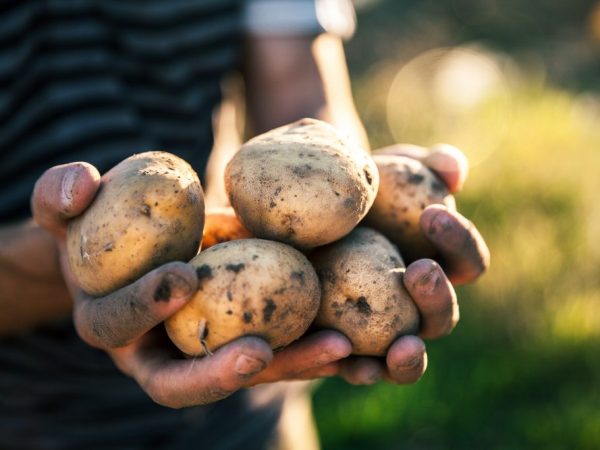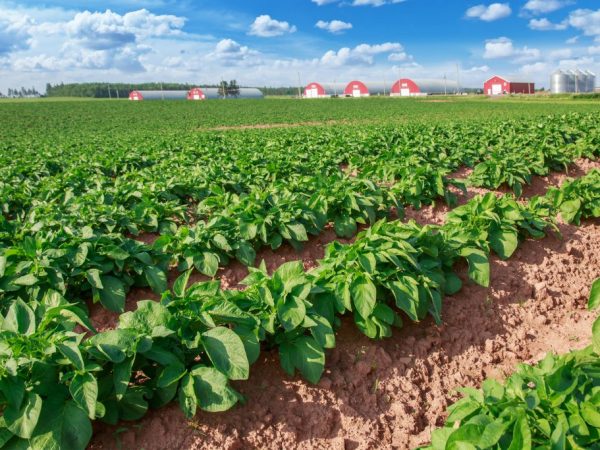Characteristics of Zorachka potatoes
Zorachka potatoes are an early variety of Belarusian selection. Forms tubers in the first half of the growing season. Average yield, excellent taste, culinary type AB. Unpretentious to soil and weather conditions.

Characteristics of Zorachka potatoes
Features of the variety
The characteristic of Zorachka potatoes testifies to the mass of its advantages over other varieties of early selection. Bush of medium height, semi-erect, with green leaves in between. The variety ripens in just 70-75 days after planting. The first tubers are dug on the 40-45 day of planting, 9-12 pieces are tied under the bunch, the average weight is 90-120 grams.
Description of tubers:
- slightly elongated oval shape;
- yellow peel with small glasses;
- light yellow pulp.
Tubers are poorly boiled, their taste is good. They contain about 14% starch and are ideal for salads and frying.
Advantages and disadvantages
Early ripe potatoes Zorachka are grown for table use.
Its main advantage is early tuberization and rapid growth of potatoes. Advantages of the variety:
- resistant to the Dalem pathotype of cancer;
- practically not affected by a nematode;
- immune to late blight;
- keeps well;
- has taste qualities;
- yield 250-315 centners per hectare;
- unpretentiousness, gives good productivity on any type of soil and in different climates.
Disadvantages of the variety: it is not resistant to the Y-virus, does not tolerate drought and requires regular watering, in greenhouses it is affected by whitefly, spider mites. Relatively resistant to mechanical damage.
Planting potatoes

Tubers germinate before planting
Tubers are germinated before planting at a temperature of 4 ° C to 21 ° C. They are scattered in a thin ball in a greenhouse or room and covered with foil. In dry air, the seeds are turned over and sprayed with water, they are covered with paper or a white cloth from direct sunlight. Vegetable growers recommend disinfecting the seed with a solution of potassium permanganate every week.
Soil preparation
The site for the culture is selected sunny. In this case, they take into account which plants were grown on it before.
Good predecessors of Zorachka:
- perennial and annual herbs;
- winter crops;
- grains and legumes;
- on the sand - lupine.
The soil is prepared in the fall. In acidic soil for 1 m² make up to 200 gr. lime. Organic fertilizers are added in the following quantities:
- in clay soil - a bucket of humus or peat;
- in a sandy one - a bucket of humus, peat and clay;
- in peat soil - 10 kg each of clay, sand and humus.
For 1 m² of land, 1 tbsp is brought in. superphosphate, 150 - 200 gr. ash, no more than 1 tsp potash fertilizers. Vegetable growers and summer residents do not recommend fertilizing the site with fresh manure. From this, the taste of the culture is significantly deteriorated. After fertilization, the soil is dug deeply, while choosing the weeds and their roots.
Planting potatoes
The seeds are planted in open ground in May, when the sprouts reach a length of 1 cm.Before that, they are treated with a solution of phytosporin-M (50 grams of the drug is diluted in 3000 ml of water). These measures will protect the plant from late blight.
Potatoes are planted by hand or mechanized. The distance between the seeds is 30-35 cm, between the rows - at least 60 cm.
Potato care
Culture requires constant care. Untimely watering or hilling entails a delay in the growth and development of the plant. In this case, it will not work to get a super-early harvest.
The land around the culture must be constantly soft. This will provide unobstructed air access to the roots. Loosening is performed every time a crust forms on its surface.
Potato care rules:
- A week after planting the potatoes, the soil is loosened with a rake or harrows. If it quickly overgrows with weeds, these measures are repeated after a week.
- After the formation of rows, the nightshades are treated with a hoe, while destroying the weeds.
- A plant with a height of 15-22 cm is covered with earth so that it does not tilt and break in the wind.
Some vegetable growers believe that it is not worth hilling plants in a hot, dry summer if it is not possible to ensure regular watering. The tubers are simply "baked" in the ground. You can't do this on a hot sunny day when the ground is dry.

Plants need good care
In the northern latitudes, where the summers are cool and it often rains, it is necessary to huddle the culture. This will protect the plant from frost and get rid of weeds.
Watering
Timely watering is a prerequisite for high crop yields. Watering the plant is necessary depending on weather conditions, region and soil moisture. If it rains often, you can forget about this event until the culture blooms.
For the entire growing season, three abundant waterings are enough:
- during the appearance of the first shoots;
- at the beginning of flowering;
- after flowering.
The Zorachka variety is sensitive to drought, in such weather it requires regular watering. Dropped leaves are a signal for urgent watering. They do this in the late afternoon, at least 3 liters of water are poured under each bush. Watering methods:
- into holes or grooves:
- sprinkling.
It is better to use the first method, since the second can cause fungal diseases. The soil around the culture must be loosened up manually every other day.
Fertilizer
The culture is fed three times throughout the growing season. The first time fertilization is applied 3-4 weeks after planting. In southern latitudes, this is done in May, in northern latitudes - in June. About 10 g of urea, 20 g of superphosphate and 10 g of potassium sulfate are taken per 1 m2. Fertilizers are dissolved in water and the crop is watered. If there is drip irrigation, it is enough to scatter fertilizers between rows. Lush and dark green tops indicate an excess of nitrogen. In this case, mineral fertilizers can be replaced with poultry droppings (for 1 m2 - 200 g of droppings).
- The second feeding is carried out after the appearance of buds, the third - after the plant has bloomed.
- Foliar dressing is carried out 2-3 times. The bushes are sprayed with a 2% solution of a mixture of superphosphate, potassium chloride and Bordeaux liquid.
- This will not only fertilize the plants, but also protect them from disease conditions and pests.
Pest control
Pests and disease conditions lie in wait for the culture everywhere, and so that this does not affect the yield, it is necessary to know the measures to combat them.
Pests and ways to combat them:
- The bear eats the tubers of a young plant. It can be identified by "moves" that are clearly visible. Pest control measures: during planting of a culture, a sprig of needles is laid on 1 m2; fill the passages with a solution of laundry soap; the passages fall asleep. The pest will leave the site and leave.
- Potato moth infects plants in southern latitudes, where they are grown 2 times a year. Caterpillars that eat leaves are dangerous. They are treated with the preparations "Bankol", "Fosbecid" according to the instructions.
- The spider mite colonizes the reverse side of the leaves, they turn yellow and fall off.Preventive measures: cleaning of the remnants of previous plants from the soil, disinfection of greenhouses.
- The Colorado potato beetle eats leaves, flowers, and plant stems. Biological pest control measures: plants are regularly examined, beetles, their eggs, larvae are collected and destroyed. Chemical methods: cultures are treated with Mospilan, Killer, Stop Beetle.
In addition, tubers sometimes rot. The reason is late blight, common scab or dry rot. These painful conditions can be easily prevented by correct planting and harvesting of tubers.
It is not difficult to grow a good harvest. It is necessary to carry out preventive measures and timely monitor crop pests.
Conclusion
Potato variety Zorachka is an early table variety. It is resistant to most painful conditions, unpretentious to soil and weather conditions. High yield and good taste, short ripening period allowed it to occupy a worthy niche among other early types of potatoes.


